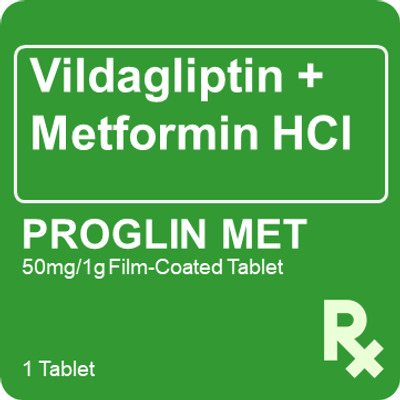GALVUSMET
Galvus Met 50mg/850mg 1 Tablet
- SKU:
- 018687
- Generic Name:
- Vildagliptin + Metformin

Galvus Met 50mg/850mg 1 Tablet
| Generic Name | Vildagliptin + Metformin Hydrochloride |
| Strength | 50 mg/850 mg |
| Indication/Usage | Galvus Met® is indicated in adults with type 2 diabetes mellitus as an adjunct to diet and exercise to improve glycemic control: • as initial therapy when diabetes is not adequately controlled by diet and exercise alone • as therapy in patients inadequately controlled with metformin hydrochloride or vildagliptin alone or who are already treated with the combination of vildagliptin and metformin hydrochloride, as separate tablets • as combination therapy- in combination with other medicinal products for the treatment of diabetes, including insulin, when these do not provide adequate glycemic control |
| Dosage and Administration | Dosage Regimen The use of antihyperglycemic therapy in the management of type 2 diabetes should be individualized on the basis of effectiveness and tolerability. Do not exceed the maximum daily dose of vildagliptin (100 mg). The recommended starting dose should be based on the patient’s condition and/or current regimen of vildagliptin and/or metformin hydrochloride. Starting dose for patients inadequately controlled on vildagliptin monotherapy Based on the usual starting doses of metformin hydrochloride (500 mg twice daily or 850 mg once daily), initiate treatment at the 50 mg/500 mg tablet strength twice daily and gradually titrated after assessing the adequacy of therapeutic response. Starting dose for patients inadequately controlled on metformin hydrochloride monotherapy Based on the patient’s current dose of metformin hydrochloride, initiate treatment at either the 50 mg/500 mg, 50 mg/850 mg or 50 mg/1,000 mg tablet strength twice daily. Starting dose for patients switching from combination therapy of vildagliptin plus metformin hydrochloride as separate tablets Treatment may be initiated with either the 50 mg/500 mg, 50 mg/850 mg or 50 mg/1,000 mg tablet strength based on the dose of vildagliptin or metformin already being taken. Starting dose for treatment naïve patients In naïve patients, treatment may be initiated at 50 mg/500 mg once daily and gradually titrated to a maximum dose of 50mg/1000 mg twice daily after assessing the adequacy of therapeutic response. Use in combination with SU (sulfonylurea) or with insulin: The dose should provide vildagliptin dosed as 50 mg twice daily (100 mg total daily dose) and a dose of metformin similar to the dose already being taken. Method of administration For oral use Administer with meals to reduce the gastrointestinal side effects associated with metformin hydrochloride. If a dose is missed, it should be taken as soon as the patient remembers. A double dose should not be taken on the same day. |
| Warning and Precautions | Vildagliptin/Metformin Not a substitute for insulin in patients requiring insulin. It should not be used in patients with type 1 diabetes or for the treatment of diabetic ketoacidosis. Vildagliptin Patients with hepatic impairment Vildagliptin is not recommended in patients with hepatic impairment, including patients with pre- treatment ALT or AST >2.5x the ULN. Hepatic enzyme monitoring Rare cases of hepatic dysfunction (including hepatitis) have been reported with vildagliptin. Vildagliptin+metformin (Galvus Met®) is not recommended in patients with hepatic impairment. Heart failure There is no experience of vildagliptin use in clinical studies in patients with NYHA functional class IV and therefore use is not recommended in these patients. Metformin Hydrochloride Lactic acidosis Interactions Concomitant medications that may affect renal function or metformin hydrochloride disposition, Administration of intravascular iodinated contrast materials, Hypoxic states, Surgical procedures, Alcohol intake, Patients with hepatic impairment, Vitamin B12 levels, Change in clinical status of patients with previously controlled type 2 diabetes, Hypoglycemia, Loss of control of blood glucose |
| Drug Interaction | Vildagliptin Vildagliptin has low potential for drug interactions. Since vildagliptin is not a cytochrome P (CYP) 450 enzyme substrate nor does it inhibit or induce CYP 450 enzymes, it is not likely to interact with co-medications that are substrates, inhibitors or inducers of these enzymes. Metformin Hydrochloride The following is known about metformin: Furosemide Furosemide increased Cmax and blood AUC of metformin with no change in renal clearance of metformin. Metformin decreased Cmax, blood AUC of furosemide, with no change in renal clearance of furosemide. Nifedipine Nifedipine increased absorption, Cmax and AUC of metformin, and increased excretion of metformin in urine. Metformin had minimal effects on nifedipine. Glyburide Glyburide produced no changes in metformin PK/PD parameters. Decreases in Cmax, blood AUC of glyburide were observed, but were highly variable. Therefore the clinical significance of this finding was unclear. Iodinated contrast agents Metformin-containing products (such as vildagliptin+metformin (Galvus Met®)) must be discontinued prior to or at the time of the imaging procedure and not restarted until at least 48 hours after, provided that renal function has been re-evaluated and found to be stable Drugs that reduce metformin clearance Concomitant use of drugs that interfere with common renal tubular transport systems involved in the renal elimination of metformin (e.g., organic cationic transporter-2 [OCT2] / multidrug and toxin extrusion [MATE] inhibitors such as ranolazine, vandetanib, dolutegravir, and cimetidine) could increase systemic exposure to metformin. Other Some drugs can adversely affect renal function which may increase the risk of lactic acidosis, e.g. NSAIDs, including selective cyclo-oxygenase (COX) II inhibitors, ACE inhibitors, angiotensin II receptor antagonists and diuretics, especially loop diuretics. When starting or using such products in combination with metformin-containing products (such vildagliptin+metformin (Galvus Met®), close monitoring of renal function is necessary. Certain drugs tend to cause hyperglycemia and may lead to loss of glycemic control. These drugs include the thiazides and other diuretics, corticosteroids, phenothiazines, thyroid products, estrogens, oral contraceptives, phenytoin, nicotinic acid, sympathomimetics, calcium channel blocking drugs, and isoniazid. Close monitoring of glycemic control and metformin dose adjustments are recommended when such drugs are administered or withdrawn for these patients. There is an increased risk of lactic acidosis in acute alcohol intoxication (particularly in the case of fasting, malnutrition or hepatic impairment) due to metformin. Avoid consumption of alcohol and medicinal products containing alcohol. |
| Requires Prescription? (Yes or No) | Yes |
1. We will deliver orders in the following areas (except in island barangays).
| a) Pangasinan ✔ Dagupan City |
|
| b) La Union ✔ Agoo |
|
| c) Ilocos Sur ✔ Tagudin |
|
| d) Ilocos Norte ✔ Laoag City |
|
| e) Bataan ✔ Orion |
|
| f) Abra ✔ Bangued |
|
| g) Pampanga ✔ Angeles City |
2. There are two (2) ways to receive your order:
a) via Home Delivery
b) via Store Pickup in any of the following St. Joseph Drug (pick-up point)i> branches:
✔ Perez Blvd., Dagupan City
✔ Mabini St., Poblacion West, Calasiao, Pangasinan
✔ Rizal St. corner Biagtan St., Poblacion, Mangaldan, Pangasinan
✔ Rizal St., Poblacion, San Fabian, Pangasinan
✔ Charms Bldg., Poblacion, Pozzorubio, Pangasinan
✔ CB Mall, Mc Arthur Highway, Nancayasan, Urdaneta, Pangasinan
✔ Zone 1 Market Road corner McArthur Highway, Villasis, Pangasinan
✔ Roxas corner Malong St., San Carlos, Pangasinan
✔ Calvo St., Mangatarem, Pangasinan
✔ Poblacion, Basista, Pangasinan
✔ Poblacion, Binmaley, Pangasinan
✔ Solis St., Brgy. Poblacion, Lingayen, Pangasinan
✔ Poblacion, Quezon Avenue, Alaminos, Pangasinan
✔ Concordia (Pob.), Bolinao, Pangasinan
✔ National Road, Poblacion, Bani, Pangasinan
✔ Mother Goose Bldg., Tapuac District, Dagupan City, Pangasinan
✔ Joleco Bldg., I, A.B. Fernandez Ave., Dagupan City, Pangasinan
✔ E&J Bldg., Milo Street, Manaoag, Pangasinan
✔ Panda Ave., Poblacion, Mapandan, Pangasinan
✔ San Guillermo, San Jacinto, Pangasinan
✔ Blue Horizon Bldg., Quezon Blvd., Poblacion, Alaminos City, Pangasinan
✔ CentroMart, Rizal St., Lingayen, Pangasinan
✔ Poblacion, Aguilar, Pangasinan
✔ Romulo Highway, Poblacion, Bugallon ,Pangasinan
✔ Gen. Luna St., Poblacion, Rosales, Pangasinan
✔ Quezon Blvd., Tayug, Pangasinan
✔ National Road, Umingan, Pangasinan
✔ Poblacion East, Alcala, Pangasinan
✔ M.H. Del Pilar St., Bayambang, Pangasinan
✔ CSI, Malasiqui, Pangasinan
✔ P. Tavera St., Poblacion, Binalonan, Pangasinan
✔ Guiset Sur, San Manuel, Pangasinan
✔ Poblacion West, Asingan, Pangasinan
✔ G/F Magic Mall, Alexander St., Urdaneta City, Pangasinan
✔ Poblacion, Infanta, Pangasinan
✔ Agbayani St., Poblacion, Sual, Pangasinan
✔ Poblacion, Urbiztondo, Pangasinan
✔ Poblacion, Sta.Barbara, Pangasinan
✔ Victoria Rd., San Nicolas Norte, Agoo, La Union
✔ CSI City Mall, Biday, San Fernando City, La Union
✔ Osmeña Street, San Fernando City, La Union
✔ Poblacion East, Rosario, La Union
✔ Brgy. Lacong, Tagudin, Ilocos Sur
✔ Hennady Bldg. McArthur Poblacion, Brgy. V, Bantay, Ilocos Sur
✔ National Highway, San Antonio, Candon City, Ilocos Sur
✔ Quezon Avenue, Vigan City, Ilocos Sur
✔ City Galore Square, J.P. Rizal cor. Ligo St., Laoag City, Ilocos Norte
✔ Trece Grande Bldg., 187 JP Rizal St. Cor. Dr. Damaso Samonte St. Brgy 19, Laoag City, Ilocos Norte
✔ National Road, San Vicente, Orion, Bataan
✔ Taft St., Zone 5, Bangued, Abra
✔ Washington St., Brgy 2 Abian, Batac, Ilocos Norte
✔ Middle Session, Baguio City, Benguet
✔ G/F Senvik Loy Bldg., La Trinindad, Benguet
✔ CSI Warehouse, Purok I Palanginan, Iba, Zambales
✔ Magic Mall, Poblacion, Sta. Cruz, Zambales
✔ Sto. Rosario St., Sto. Domingo, Angeles City, Pampanga
3. We charge the following delivery fee:
| Mode of Delivery | Delivery Fee |
|---|---|
| Home Delivery | Delivery fee starts at P60.00 for the first four (4) kilometers. Additional amount will be charged depending on the distance of the shipping address you specified (please refer to the Shipping Fee Directory). |
| Store Pickup | Free of Charge |
4. We will deliver your order as follows:
a) for Home Delivery
| Orders Received | Delivery Schedule |
|---|---|
| Before 1:00pm | Same day delivery within 2:00pm to 6:00pm |
| After 1:00pm | Next day delivery within 2:00pm to 6:00pm |
b) for Store Pick-up
You may expect your order to be ready within 2 hours to a day (depending on the availability of ordered item) upon placement of order. You will be notified via call/SMS once your order is ready for pick-up. We encourage you to claim your order within 3 days (during store hours) upon receipt of advice that your order is ready for pick-up, otherwise, such shall deemed as cancelled.
5. We will deliver your order from Monday to Sunday (including holidays) from 2:00pm to 6:00pm.
6. There are two (2) ways to track your order:
a) For every change in the order status, an email will be sent to you.
b) You can also check your order status by signing-in to your account. Just go to “My Account” and click “Orders” to display the order status.
7. In case you are not home when your order arrives, you may have a representative receive and pay the package for you. However, if payment was made via bank transfer, your representative shall be required to present the following:
a) Authorization Letter; and
b) Your Valid ID (with picture and signature) and that of your representative.
8. If nobody is available to receive your order, our Rider will bring your package back to St. Joseph Drug pick-up point branch nearest/ covering the shipping address you specified, for pick-up within the 3-day claiming period or you can have it redelivered but with a corresponding redelivery fee.
ITEM RETURN/ EXCHANGE/ REFUND1. All products ordered from St. Joseph Drug are subject to quality checking by our designated personnel prior to delivery to/ pick-up by customers.
a) Upon delivery to / pick-up by customer:
✔ Please inspect your package in the presence of our Rider/Pharmacy Assistant. Your signature on the Acknowledgement Receipt signifies that you have received the products completely, correctly, and in good condition (not damaged / defective and / or expiring / expired).
✔ You may refuse to accept the product if such is incorrect, incomplete, or not in good condition. For home delivery, we will redeliver the replacement or additional item/quantity free of delivery charge.
b) After delivery to / pick-up by customer:
✔ We will still accommodate request for item return / exchange / refund under the following conditions:
- Promptly returned within 7 days upon receipt of the product
- Duly supported by St. Joseph Drug official receipt
Note : We may require additional documents (e.g. photo of the affected product) to support your request.
✔ The following items will be acceptable:
- items in good condition provided such are:
- not in a vial
- not loose tablets/capsules
Note : The product must be in its original box/packaging (unused) and complete with gift/promo item (if any).
- products with explicit manufacturing defect
Note : Damaged / defective items due to customer's mishandling or improper use will not be accepted.
✔ Once your request is approved, we will redeliver the replacement or additional item/quantity but with a corresponding redelivery fee (except for products with explicit manufacturing defect which we will redeliver free of delivery charge).
✔ Requests for refund will be reviewed and handled on a case-by-case basis and subject to management's approval.
2. To request for item return/ exchange/ refund, perform any of the following:
a) contact 0917-565-3700 or 0998-530-3700; or
b) report via our live chat/ messaging; or
c) proceed to St. Joseph Drug Perez Blvd., Dagupan City branch.
Note : Request for return/ exchange/ refund of items ordered via our Online Store will not be accepted in any other St. Joseph Drug branches.
3. Requests for item return/ exchange/ refund will be processed within 2-3 working days upon receipt of the required supporting documents. You shall be notified via call/ SMS once the request has been approved.
Neque porro quisquam est qui dolorem ipsum quia dolor sit amet
Lorem ipsum dolor sit amet, consectetur adipiscing elit. Nulla at venenatis eros. Nulla efficitur, orci ut cursus consectetur, nisi elit convallis odio, non hendrerit arcu tortor aliquet eros. Nullam imperdiet diam ut neque ullamcorper semper. Mauris consequat ex sed elit venenatis, eu varius nulla posuere. Nullam gravida mattis velit, id commodo nunc rhoncus ut. Phasellus congue felis tortor, nec eleifend lacus tincidunt vitae. Nullam dapibus tempus tempor. Maecenas massa neque, tempus in efficitur at, scelerisque sed tortor. Morbi vulputate ipsum odio, non posuere sem suscipit accumsan. Cras fermentum nunc quis tempor iaculis. Praesent dictum augue sit amet neque faucibus, ac varius enim convallis. Curabitur volutpat ligula sit amet nibh vehicula egestas. Etiam eget dolor ipsum. Phasellus varius, metus sit amet aliquet tempor, erat ante rhoncus magna, quis vehicula tortor nunc at ipsum. Duis vitae erat vitae turpis cursus pretium. Quisque pulvinar sapien at mi efficitur, sed faucibus nulla accumsan.
Ut a leo interdum, imperdiet ante quis, euismod quam. Nam eget auctor risus. In a bibendum diam. Curabitur non lectus pharetra, maximus dolor mattis, auctor dolor. Maecenas placerat ipsum vitae elementum vulputate. Morbi lacinia libero lorem, in dignissim ante convallis at. Pellentesque habitant morbi tristique senectus et netus et malesuada fames ac turpis egestas. Sed in purus vulputate sem tempor tincidunt ac sed turpis. Pellentesque erat justo, feugiat eget vestibulum molestie, cursus ac ex. Phasellus magna enim, placerat non lacus varius, cursus consectetur urna
Phasellus finibus nulla vitae malesuada efficitur. Pellentesque habitant morbi tristique senectus et netus et malesuada fames ac turpis egestas. Phasellus sed pharetra risus. Quisque ante sem, faucibus id velit eget, bibendum sodales purus. Donec congue ipsum leo, aliquet aliquam lectus suscipit et. Pellentesque viverra, enim et pulvinar aliquet, dolor magna gravida lectus, sit amet pellentesque turpis elit id enim. Nulla a lectus viverra, ultricies urna ac, cursus turpis. Sed et purus vitae nunc molestie molestie sit amet eget nisl. Ut non nunc erat. Orci varius natoque penatibus et magnis dis parturient montes, nascetur ridiculus mus. Orci varius natoque penatibus et magnis dis parturient montes, nascetur ridiculus mus
Suspendisse imperdiet enim in porttitor dignissim. Nam iaculis enim vel nunc commodo cursus. Donec vitae magna eget nunc fringilla pharetra vitae id risus. Proin in aliquam ex. Ut purus sem, fermentum ut aliquam at, ornare quis nisl. Aliquam feugiat dapibus nunc, sit amet aliquam metus sollicitudin eget. Integer gravida ligula vitae leo suscipit, eget pretium augue tempus. Integer fringilla justo id purus pulvinar iaculis. Fusce in lorem pulvinar, suscipit ipsum id, volutpat dui. Fusce eu sem sapien. Duis sit amet nisi leo.
















